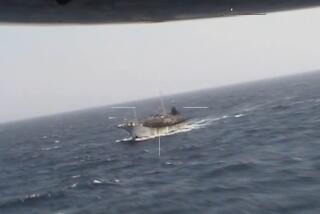A U.S.-Soviet ‘Success Story’ at Sea
- Share via
VLADIVOSTOK, Soviet Union — The northern Pacific Ocean is often stormy and rough, but the only Soviet-American joint business venture has found smooth sailing in the area.
A small group of American fishermen, combining forces with Soviet sailors on factory ships, have made good business and good friends for almost 10 years.
Their company is known as Sovam and, in a time of roller-coaster relations between the superpowers, it has been kept on a remarkably even keel.
The experience may be helpful to others, for the Soviet Union is trying to persuade other Western firms to engage in joint ventures in a variety of fields in an effort to speed economic development of the Soviet Far East.
In Sovam’s first season, in 1978, it caught and processed less than 1,000 tons of fish. But last year the catch was 223,000 tons, with a value of more than $70 million. The target for 1987 is even higher.
The company’s history indicates that the Soviet partners value human relations as much as good business relations.
The unusual hands-across-the-sea story was told at the Vladivostok headquarters for Soviet fishing operations in the Pacific. Boris I. Trofimenko, director of a major fishing fleet, said: “It’s highly profitable for both sides, but it’s not just a business. They’re sharing bread and salt”--traditional symbols of hospitality.
‘Simple and Vital People’
In Moscow, Paul Allison, the U.S. director of Sovam, agreed with Trofimenko.
“It’s a straight success story,” he said. “When politics are not in the way, fishermen tend to see things the same. They are simple and vital people, and they like each other.”
On the American side, one of the more colorful captains is Barry Fisher, who went to sea at age 15 and made two dangerous voyages to Murmansk during World War II carrying military supplies to the Soviet Union.
Fisher, now senior captain and spokesman for the American fishermen, sent a check for $5,000 to the Soviet Union to help victims of last year’s nuclear accident at Chernobyl, a Soviet official recalled.
Capt. Boris Nadein of the Soviet factory ship Sulak said of his experience with American fishing crews: “It’s excellent work. We spend eight or nine months, side by side, often in stormy seas, and you can see then who’s worth what. Of course, we had arguments, and occasionally very hot ones. But always one side or the other yielded, and we were able to find a compromise.”
The joint venture began in 1976, with the opening of a Moscow office. Combined fishing operations began in 1978, with a handful of American trawlers and Soviet fish-processing vessels meeting off the Aleutian Islands.
In 1977, the United States’ declaration of an “economic zone” extending 200 miles from its shores made it more difficult for Soviet fishing vessels to work, so an agreement was reached: American ships bring in the fish and turn them over to Soviet factories for cleaning, freezing and packaging.
The fish are marketed around the world through Sovam, which also has an office in the Soviet port of Nakhodka, about 120 miles southeast of here.
The Americans fish from high-tech trawlers well-equipped with electronic gear. The trawlers are worth $2 million to $3 million each and range in length from 65 to 130 feet. Their four- or five-man crews spend weeks at a time away from port, often in extreme cold and heavy seas. The Soviet factory ships, some as long as 550 feet, carry crews of as many as 400.
Soviet Capt. Peter Magalyas, who has spent years working with Americans, said: “Each fish-catching ship ties up to a factory ship three times in 24 hours, and this leads to frequent contact on a wide variety of questions. We have to interact as human beings.”
There is a Russian-speaking American representative of Sovam on board each Soviet ship to help with liaison. In addition, some of the Soviet officers and crew members can speak enough English to communicate with the Americans.
Consequently, Americans are often invited to dine on borscht and black bread or to cook hamburgers in Soviet galleys. The fishermen also take showers, receive medical care and give their sea legs a rest on the larger, more stable Soviet ships.
In repayment for this hospitality, the Soviet crews have been allowed to come ashore when their ships are refueling and taking on supplies in Alaskan ports. On one such visit, to Dutch Harbor, they played football with the Americans and went to a dance.
“Many invisible threads bound us together over these long years,” Nadein of the Sulak observed.
The founder of Sovam is James Talbot of Seattle, who hopes to parlay this success at sea into new joint projects on land. He has submitted proposals to build a fast-food fish cafe in Nakhodka, to put up a cold-storage facility there and to cooperate in construction of a cardboard factory.
“To be quite frank, I look with optimism at development of relations between our countries,” Talbot was quoted as saying in a recent interview with Pravda, the Communist Party newspaper.
More to Read
Sign up for Essential California
The most important California stories and recommendations in your inbox every morning.
You may occasionally receive promotional content from the Los Angeles Times.













